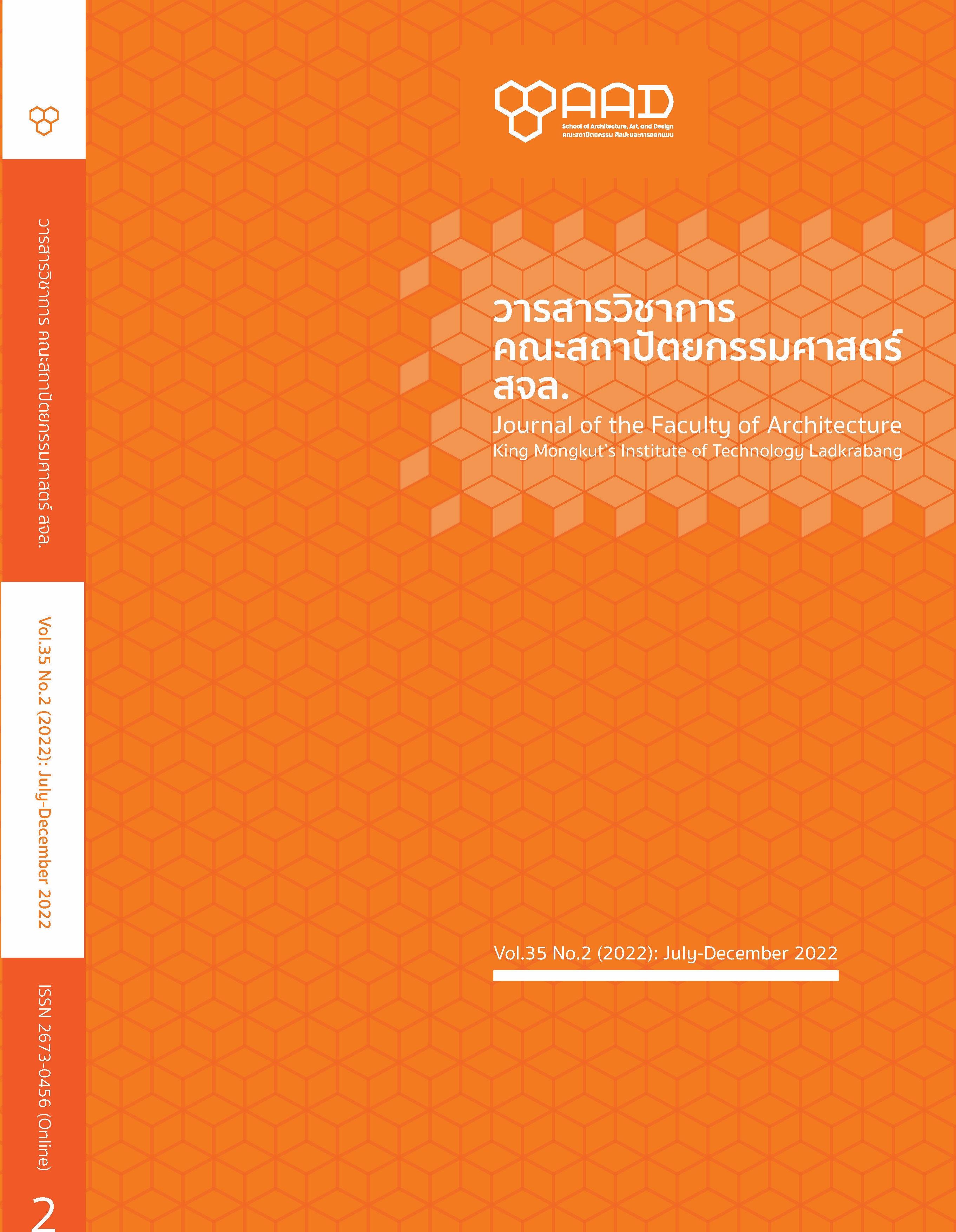Levels of Satisfaction with the Active Learning Outcomes for Interior Design Project: Panya Wattana Building, National Institute for Child and Family Development
Main Article Content
Abstract
The objective of this research was to evaluate the level of satisfaction of students and the satisfaction of agencies in external educational institutions with the project-based learning process for an interior design project. The research is a project-based learning to the assess the satisfaction of learning from the interior design project among the students and project users from National Institute for Child and Family Development by means of a series of questionnaire. And what content should be added to the study of interior architecture? The research assigned the students to the following: 1) survey the area, interviewed the preliminary needs of the staff, and investigated the possibility of renovating the building. 2) Present the design concept and ask for additional feedback from users, then use the information to design and present the design to users. 3) Make a construction drawing and list of drawings to make a bill of quantities (BOQ). 4) Assessment of satisfaction with learning from the performance of the questionnaire. The sample group in the research was 56 students in the field of Interior Architecture who was assigned to design and prepare the construction drawings, working with 4 advisors and 20 staff from the National Institute for Child and Family Development.
The results showed a level of satisfaction with the practical learning process in this design project of students and staff from the National Institute for Child and Family Development. The results also showed a high level of satisfaction with working together among students, advisors and staff from the National Institute for Child and Family Development. This project-based learning process allows students to learn in practice and gain experience working with others. And this project-based learning process can be adapted to teaching by students offering additional content on fieldwork, interview methods, data analysis based on priorities and suitability, cost estimation, and Presentation of work.
Article Details

This work is licensed under a Creative Commons Attribution-NonCommercial-NoDerivatives 4.0 International License.
This work is licensed under a Creative Commons Attribution-NonCommercial-ShareAlike 4.0 International License.
Copyright Transfer Statement
The copyright of this article is transferred to Journal of The Faculty of Architecture King Mongkut's Institute of Technology Ladkrabang with effect if and when the article is accepted for publication. The copyright transfer covers the exclusive right to reproduce and distribute the article, including reprints, translations, photographic reproductions, electronic form (offline, online) or any other reproductions of similar nature.
The author warrants that this contribution is original and that he/she has full power to make this grant. The author signs for and accepts responsibility for releasing this material on behalf of any and all co-authors.
References
กมล โพธิเย็น. (2564). Action Learning: การจัดการเรียนรู้ที่ตอบโจทย์การจัดการศึกษาในศตวรรษที่ 21. วารสารศึกษาศาสตร์ มหาวิทยาลัยศิลปากร. 19(1), 11-28.
คุ้มพงศ์ หนูบรรจง. (2562). กระบวนการออกแบบสถาปัตยกรรม. พิมพ์ครั้งที่ 2, กรุงเทพฯ: มีนเซอร์วิสซัพพลาย.
จันทนี เพชรานนท์. (2559). การทำรายละเอียดประกอบการออกแบบสถาปัตยกรรมภายใน. กรุงเทพฯ: คณะสถาปัตยกรรมศาสตร์ สถาบันเทคโนโลยีพระจอมเกล้าเจ้าคุณทหารลาดกระบัง.
ชมพู เนื่องจํานงค์, ภัทรยุทธ โสภาอัศวภรณ์ และอัจฉรา ธนีเพียร. (2563). กรอบทักษะการเรียนรู้ในศตวรรษที่ 21 กับการจัดการเรียนรู้โดยใช้โครงงานเป็นฐาน. วารสารวิชาการสถาบันเทคโนโลยีแห่งสุวรรณภูมิ. 6(1), 623-640.
ปรียานุช พรหมภาสิต. (2559). คู่มือการจัดการเรียนรู้ “Active learning (AL) for HuSo at KPRU”. กำแพงเพชร: คณะมนุษยศาสตร์และสังคมศาสตร์ มหาวิทยาลัยราชภัฏกำแพงเพชร.
ภาศิริ เขตปิยรัตน์. (2553). การประเมินความพึงพอใจของนักศึกษาที่มีต่อหลักสูตรบริหารธุรกิจ คณะวิทยาการจัดการ มหาวิทยาลัยราชภัฏอุตรดิตถ์. กรุงเทพฯ: ฐานข้อมูลโครงสร้างพื้นฐานภาครัฐด้านวิทยาศาสตร์และเทคโนโลยี กระทรวงวิทยาศาสตร์และเทคโนโลยี.
ราชบัณฑิตยสถาน. (2554). พจนานุกรมศัพท์สถาปัตยกรรมศาสตร์ ฉบับราชบัณฑิตยสถาน. กรุงเทพฯ: ธนาเพรส.
วีระยุต ขุ้ยศร. (2557). ปัจจัยที่ทำให้เกิดความคิดสร้างสรรค์ในวิชาวิเคราะห์การออกแบบ สาขาวิชาสถาปัตยกรรมและการวางแผน คณะสถาปัตยกรรมศาสตร์ สถาบันเทคโนโลยีพระจอมเกล้าเจ้าคุณทหารลาดกระบัง. วารสารวิชาการคณะสถาปัตยกรรมศาสตร์ สจล.. 18(1), 65-78.
วีระยุต ขุ้ยศร. (2565). หลักการเขียนแบบเบื้องต้นสำหรับสถาปัตยกรรมภายใน. กรุงเทพฯ: คณะสถาปัตยกรรม ศิลปะและการออกแบบ สถาบันเทคโนโลยีพระจอมเกล้าเจ้าคุณทหารลาดกระบัง.
สมชาย บุญสุ่น. (2554). ความพึงพอใจของนิสิตที่มีต่อการเรียนการสอนของมหาวิทยาลัยมหาจุฬาลงกรณราชวิทยาลัย จังหวัดพระนครศรีอยุธยา. (วิทยานิพนธ์ปริญญาพุทธศาสตรมหาบัณฑิต สาขาวิชาการบริหารการศึกษา บัณฑิตวิทยาลัย, มหาวิทยาลัยมหาจุฬาลงกรณราชวิทยาลัย).
ศิริวิมล ใจงาม. (2556). การออกแบบการเรียนรู้ที่เป็นสากล: เอกสารประกอบการอบรมหลักสูตรการพัฒนาศักยภาพบุคลากรที่เกี่ยวข้องกับการจัดการศึกษาสำหรับคนพิการในระดับอุดมศึกษา. พิมพ์ครั้งที่ 2. กรุงเทพฯ: สำนักงานคณะกรรมการการอุดมศึกษา.
อภิชาติ บุญมาลัย. (2559). การเรียนรู้โดยใช้โครงงานเป็นฐาน (Project-based Learning: PBL). วารสารการจัดการความรู้ พ.ศ. 2559 มหาวิทยาลัยราชภัฏนครสวรรค์. 1(1), 113-131.
อรรถพร เพชรานนท์. (2558). การออกแบบสถาปัตยกรรมภายใน. พิมพ์ครั้งที่ 3. กรุงเทพฯ: คณะสถาปัตยกรรมศาสตร์ สถาบันเทคโนโลยีพระจอมเกล้าเจ้าคุณทหารลาดกระบัง.

